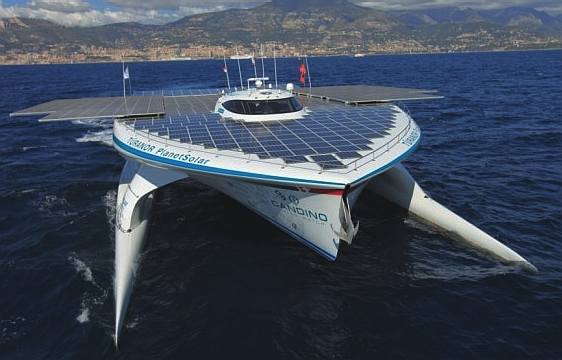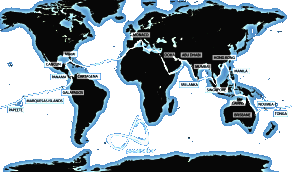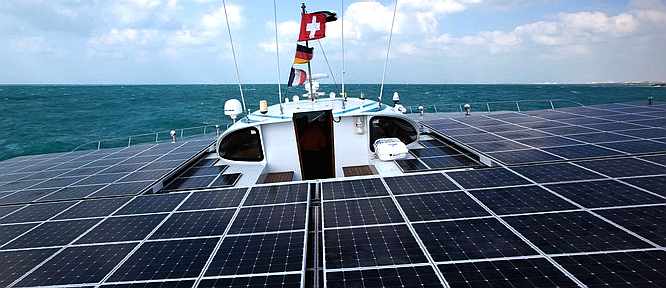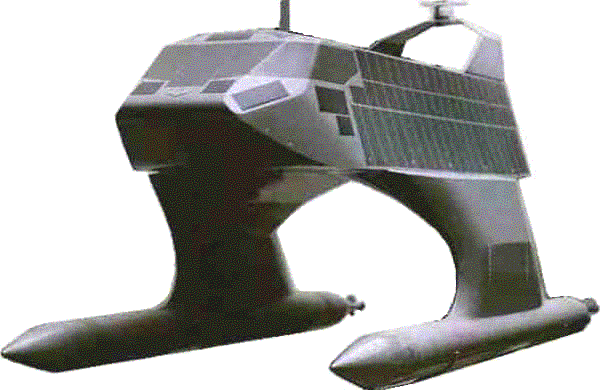|
PLANET SOLAR - PROJECT LAUNCHED 16 March 2006
|
||||||||||||||||||||||||||||||||||||||||||||||||||||||||||||||||||||||||||||||||||||||||||||||||||||||||||||||||||||||||||||||||||||||||||||||||||||||||||||||||||||||||||||||||||||
|
SOLAR HISTORY - The above illustration is taken from an original map of a proposed solar circumnavigation dating from 1991. This map was later displayed at the Earls Court Boat Show in 1994 as the background for a show stand. Inspired by what is known as the Sunshine Route on this map, the Cleaner Ocean Foundation have conducted their own investigation as to a potential ocean awareness campaign, the results of which are seen in the table below. The objective is to improve on the magnificent record set by PlanetSolar in 2012. You can see more information of the destination ports by clicking on the locations in the Waypoints column.
TRANSIT EXAMPLES - The above table illustrates one of the most likely ocean awareness expedition routes showing the time elapsed in days for 7 knots average cruising speed, including times for 5 and 6 knot averages - allowing for 10% downtime and 36 days in ports. Hence, although the objective is to reduce the current solar circumnavigation record from 584 days, the event in not an outright non-stop yacht competition in the offshore racing sense. It remains to be seen how accurate such a prediction might be.
PlanetSolar docks in Paris, France September 2013
The following is an email that we received from Raphaël Domjan & Immo Stroeher on the 17th of April 2012:-
Dear PlanetSolar Friends,
I am writing to you from the cockpit of PlanetSolar. We are back in Europe and currently docked in Greece. It is a great moment for the whole PlanetSolar team and myself. After eight years of effort, our goal is finally in sight. We have covered more than 58’000 km thanks to the sun’s energy and crossed all the Oceans of the planet.
The Red Sea is a true corridor with a powerful wind coming down from the North. Now and then we had to face winds blowing at more than 35 knots (70 km/h). We decided to stay on the west coast. Once more Mother Nature has protected us. Conditions remained favourable as long as we were sailing along the coasts, where no stopover was possible. From the moment when we reached Sudan, we had to make unexpected stopovers to charge our batteries. We used this occasion to discover places as unlikely as they were wonderful. Such a place is Port Sudan, an amazing city and country, inhabited by people of infinite kindness.
PlanetSolar coming into harbour in Venice, Italy after a tour of the Mediterranean Ocean, October 2014
In Sudan, we were also lucky enough to visit the site of Commander Jacques Yves Cousteau’s underwater village, PréContinent II. It is here that six men lived underwater during one month in summer 1963. Albert Falco, one of our ambassadors, was one of those six men. It is an incredible moment to be here, 50 years after their expedition, with the world’s largest solar ship during the first sail up of the Red Sea with solar energy. I organise the dive on the site and we quickly find the remains of the village. After an exploratory dive with Jens, I accompany Gérard. Christian and Jens will be the last to dive. Thank you Sir Cousteau, thanks to Falco and all the team of the Calypso, it was a first… Moments out of time …
Gérard d’Aboville, who had joined us in Djibouti and sailed up the Red Sea with us, is leaving us in Hurghada, Egypt. He has to go back to Paris. Crossing the Suez Canal for the first time with a solar ship was a moving moment. We thank the authorities of the Suez Canal for their help and we also thank Mr Ferdinand de Lesseps and the Egyptian people who allowed our expedition to get back to the Mediterranean Sea.
In the spirit of transparency and for the sake of our adventure, it is important to officially certify the success of the first world tour with solar energy. This is the reason why the UIM (Union Internationale Motonautique, member of the International Olympic Committee) is responsible for the certification of our world tour and our expedition is under its patronage.
We are keeping the expedition logbooks up to date. Every time we get to a new country, we let the custom and immigration authorities stamp our books as proof of our passage. We are sending our positions via two satellite beacons every 30 minutes. A notary has sealed our charging cables and emergency generators in Monaco. At our arrival, he will come and check that they are still in place. Our world tour will only be completed once we cross the finish line and our batteries are charged up to a minimum of 92%, in line with the battery charge level we had at the beginning of our journey.
From that moment we will have completed the first world tour respecting the strictest rules: passing the equator twice, crossing of our antipodal route, crossing all the longitude lines, and same point of departure and arrival. All of this achieved with the energy of our solar cells only.
We now have to reach Italy and then sail toward Corsica. Patrick Marchesseau will meet us there and we also hope to have a few days of rest to recharge our batteries and take on the last miles of this world tour. Come and be there with us for this historic moment, join us in Monaco on the 4th of May 2012 …
If everything goes well, we will see you in Monaco on the 4th of May 2012 after crossing the finish line and succeeding in this first world tour with solar energy. For those who will not be able to attend in Monaco, the crossing of the finish line as well as the press conference will be broadcasted live on our « SolarWebTV »! Do not miss this moment and follow the arrival in real time on our website (http://www.planetsolar.org).
We thank you all for your support. Raphaël
Domjan, Founder & Expedition
leader
PS:
Do not forget to buy your own PlanetSolar products and become part of
the Expedition! Visit our E-Shop here.
The PlanetSolar team presented their extraordinary challenge: Around the World in 80 Days Powered by Renewable Energies. During a press conference held on Thursday, March 16, 2006, at 10:30 am, at The School of Business and Engineering Vaud, Switzerland, in its assembly hall.
PROPOSED ROUTE:
Initially, the team Around the World with Stopovers, Powered by Solar Energy, in 120 Days. The first objective was to successfully complete an around the world route with stopovers along the equator, where the maximum amount of sunlight is available. The over 40'000 km voyage should take place within 120 days and will be sailed at an average speed of 10 knots. Both navigators aboard the PlanetSolar will cross through the western part of the Mediterranean Sea, the Atlantic Ocean, the Panama Canal, the Pacific Ocean, the Indian Ocean and finally the Suez Canal, crossing the finish line at the start off point in the Mediterranean Sea.
THE ACTUAL ROUTE TAKEN:
The first solar electric world circumnavigation was from the East to the West. The Tûranor Planet Solar departed on 27 September 2010 from Monaco. The team followed a route close to the Equator as per the Solar Navigator's planned route. After crossing the Atlantic ocean, the Panama Canal, the Pacific ocean, the Indian ocean, the Suez Canal, and the Mediterranean, the ship will reach Monte Carlo with an estimated time of arrival set to spring 2012.
Original PlanetSolar design - solar powered trimaran
THE ORIGINAL BOAT
A Harmony between Technology and Poetry. With its impressive photovoltaic solar wings spanning 180 m2 and its wave-piercing third, or centre hull, that cuts through waves), the innovative PlanetSolar trimaran imitates the graceful landing of a swan, as it skims the water with its feet. These are the words of the team to describe their vessel.
Indeed, in spite of its remarkable proportions (see below), and the absence of sails, it gives the impression of being an enormous immaculate, white bird of the sea; with a sense of lightness and fluidity owing to its pure design. However, underneath the poetry of its sublime silhouette, lies a boat at the forefront of technology, as envisioned by the MW-Line Ltd. Company. MW-Line has already successfully built the fleet of Aquarel Boats now running on Lake Léman as well as the solar powered catamarans used at the 2002 Swiss National Exposition, Expo.02.
Maximum research has been undertaken to insure that this futuristic craft will be able to charge its storage batteries even with a minimum amount of sunlight available. The PlanetSolar engineers must oversee the boat's propulsion system, the solar panels' energy yield and energy storage, all the materials used in the boat's construction and the environmental conditions. A 10 kW motor power would be sufficient to propel the boat to an average speed of 10 knots (18,5 km/h). The storage batteries capacity is aimed at covering navigation autonomy of at least 48 hours; without any additional energy input.
Final PlanetSolar model design - solar powered catamaran
The Hybrid Vehicle: The Solution for the Future
With the exception of renewable energy propulsion, PlanetSolar's additional goal is to demonstrate that the hybrid vehicle will be the ideal transportation solution for the near future. During PlanetSolar's around the world voyage with stopovers, energy used for data processing, telecommunications and automatic pilots will be generated by a fuel cell that will furnish 300 W to 400 W of power. In spite of the severe conditions encountered, this fuel cell, as well as its output, should require only a minimum amount of hydrogen to be put a board the boat.
In the longer term the PlanetSolar team had suggesting using fuel cells for far greater power. They claimed that this would lead to an increase in the boat's speed, as well as its greater autonomy. These optimal conditions will come together in time, promising faster navigation on southern route, without stopovers, in 80 days. We here at SN think that fuel cells are overrated, expensive and have a short lifespan. That is of course our opinion. It's also a pity, but who knows what the future will bring?
Christened Tûranor PlanetSolar, which means power of the sun in J.R.R Tolkien mythology, this clean vessel was launched in March 2010 in Kiel, Germany, in the shipyards of Knierim Yachtbau. Construction took 14 months to complete.
THE ACTUAL BOATS SPECIFICATIONS:
Length: 31 meters Length
with flaps: 35m Width with flaps: 23m Height: 6.10 meters Draft:
1.55m PV
panel efficiency: 18.8% Motor max power: 120Kw Average
motor consumption: 20Kw (26.8 HP) Crew:
4
The designer of PlanetSolar, Craig Loomes is from New Zealand. He has already spawned numerous innovative ship desings. The light carbon structure played its part in ensuring the completion of this incredible adventure.
PlanetSolar is currently the biggest solar ship in the world (at 17-4-12). 537 m2 of photovoltaic panel power 6 blocks of lithium-ion batteries. This technology offers maximum power and energy density, thus enabling a navigation time that is unmatched to date!
However, Solar Navigator is set to challenge that record with a more efficient hull form and a power to weight ratio more than twice that of the TPS. According to our reckoning the power to weight ratio of Planet Solar is: 93.5Kw / 95 tons = .9843Kw/ton. According to our estimates Planet Solar will have covered around 32,100 miles in 442 days, which = 72.63 miles a day, or an average speed of 2.63 knots (3mph). It's one heck of an achievement to beat, but the SN team are going to give it a go, provided that the 5th test model lives up to expectations and funding is secured.
THE ORIGINAL CREW
The project's founder will be one of the two navigators setting off to sea. An internationally acclaimed skipper will join him (whose name will not be divulged for the time being).
Project Launch March 2006
ORGANISATION
This project is carried out by the PlanetSolar association which remains apolitical, and is governed according to articles 60 of the Swiss Civil Code. Its Executive Committee is the representative authority for the organization and supervises the entire project.
COMMITTEE
The Executive Committee (strategic stakeholders) are:
March 2012 the PlanetSolar in the Suez Canal
SPONSORSHIP COMMITTEE
Members
January 2012 Abu_dhabi, wings extended
« The PlanetSolar project is part of the Vernien endeavors; humanitys hope for a better future in a world that seems to be calling into question all the dangers that threaten it. While reading about this research program on innovative vehicles that are safe for the environment, my thoughts turned to Jules Vernes novel, «The Begums Fortune», which brings to the forefront a vision of short term profit making at the cost of destruction; a vision that considers both nature and mankind. Even though it is a bit exaggerated in certain aspects, this ecological opus depicts all of our own contradictions and hopes. In the spirit of the PlanetSolar project that calls upon scientists, technicians, industries, financiers and scholars who are working together on an "extraordinary voyage into known and unknown worlds," I am writing these few words at the same time our society is asking the unthinkable question of its own survival. A special thanks to my Great-Grandfather Jules Verne who has given the PlanetSolar team the idea, the will, the audacity and who has inspired such an exciting, valuable project.»
ACTUAL SPONSORSHIP
Private and Public Donations
General Conditions
The PlanetSolar project's sponsors and partners share in a global view towards the planet's and mankind's sustainable development. They are ready to undertake the challenges of this project. Their collective philosophy meets and respects all elements of the PlanetSolar project.
Sustainable Development of the Project
In order to reach its goals, especially concerning communication towards the general public, the project will be highly visible at the international level over several years time. After the boats first around the world tour, without stopovers, the boat will be kept in use and continue to attain high standard performance. It will also continue in its role as a renewable energy laboratory.
World route map
PlanetSolar
Postal Account: 17-450479-6 By
E-mail : info@planetsolar.org
Design concept - Construction - Raphael Domjan - PROMOTIONAL TOUR 2012 English - Swiss - French - History - Links - Homecoming
2013 Geneva University Deepwater Gulf Expedition
London - Paris - Rio de Janeiro - Gerard d'Arboville
Other European Solar Boats -
The Solar Navigator - 2nd test model 1995
The 6th Solar Navigator design underwent evaluation tests the aim being to improve on the record set by the current holders: PlanetSolar. The latest design is quite a looker, packed with high tech features and is the subject of a patent applied for in 2013 and published in 2014.
|
||||||||||||||||||||||||||||||||||||||||||||||||||||||||||||||||||||||||||||||||||||||||||||||||||||||||||||||||||||||||||||||||||||||||||||||||||||||||||||||||||||||||||||||||||||
|
The names Bluebird™, Bluefish™, Elizabeth Swan™ and the blue bird & fish in flight logos are trademarks. The color blue is reserved for associate licensees and is a distinctive feature of the Marks. All other trademarks are hereby acknowledged. Contact Bluefish.
|
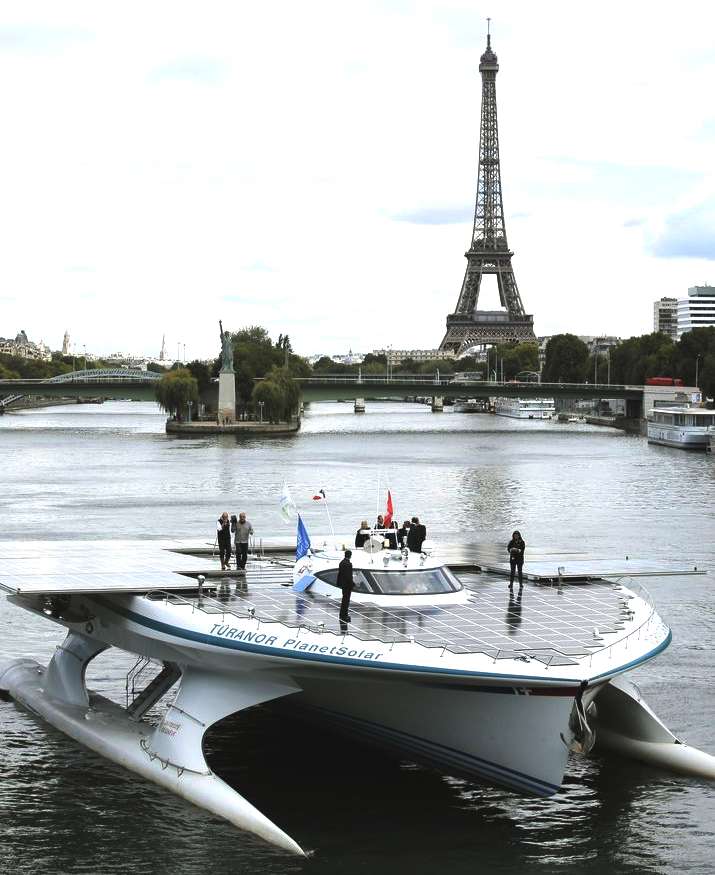
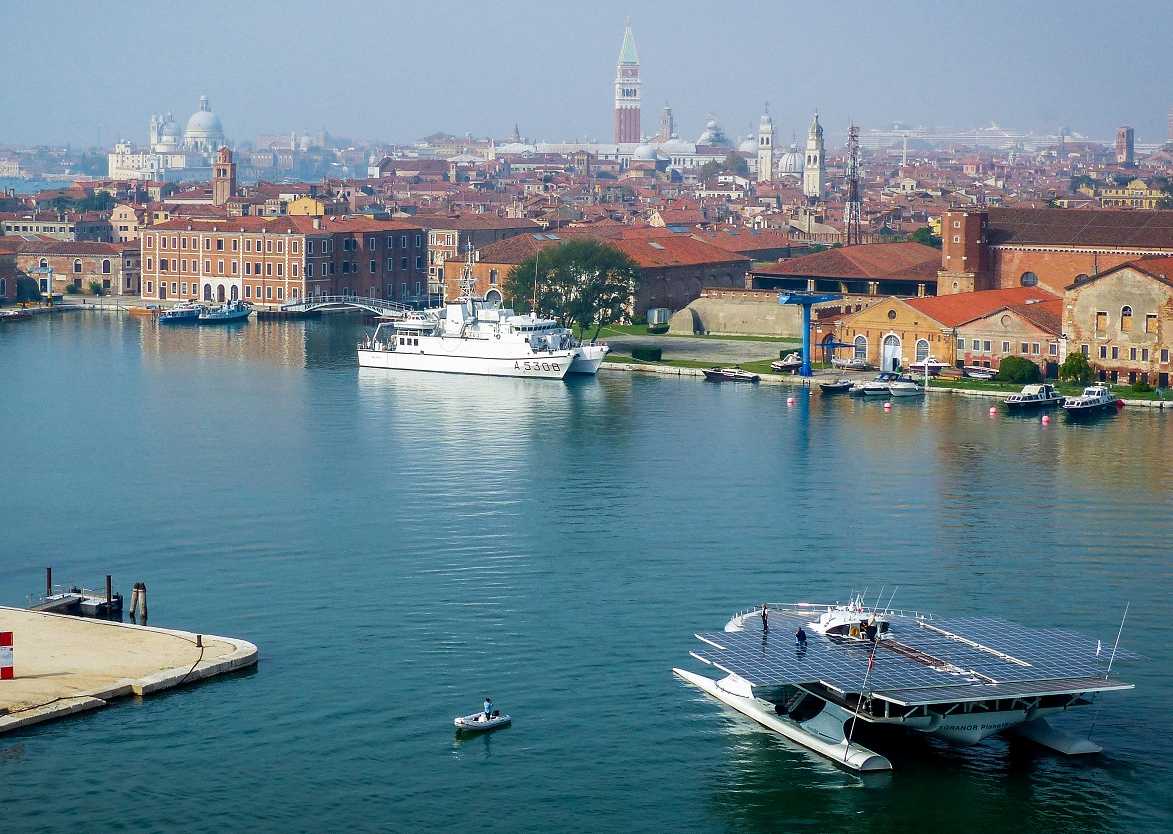
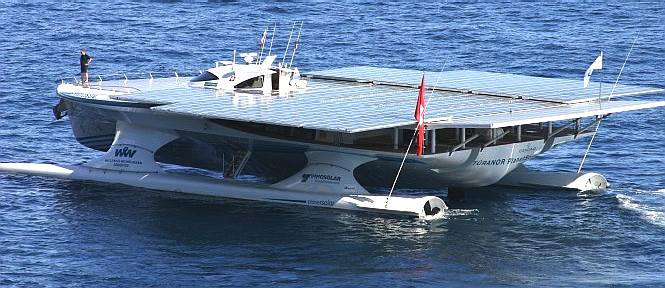
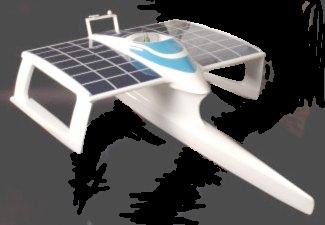
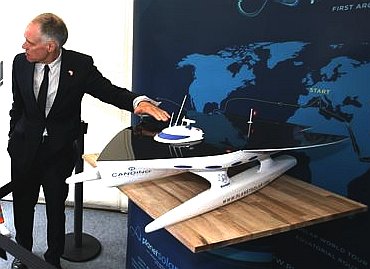
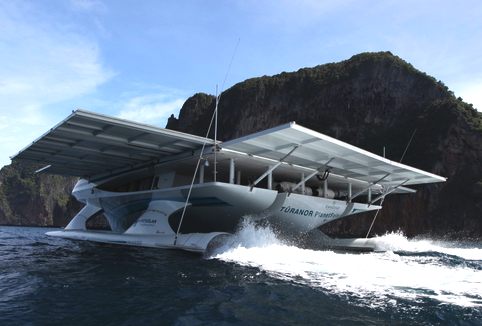
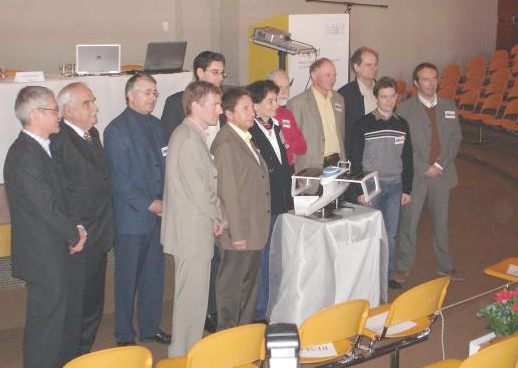
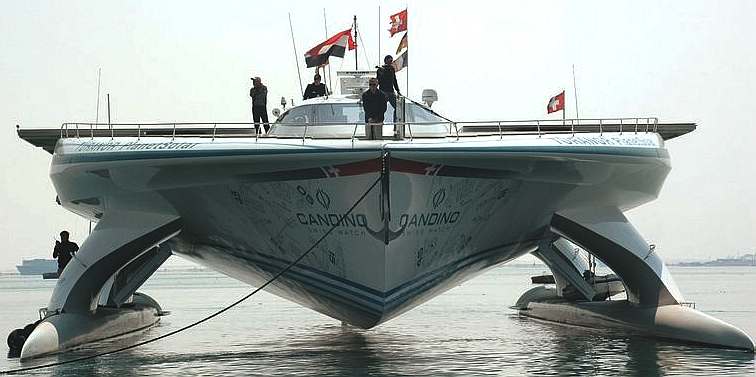
 Jean-Louis
Aucouturier, Professor Emeritus at the ENSEIRB Graduate Engineering
School - Bordeaux Science and Technology University and
President-Founder of the Electric Boats of France (l'Association française
pour le bateau électrique - AFBE).
Jean-Louis
Aucouturier, Professor Emeritus at the ENSEIRB Graduate Engineering
School - Bordeaux Science and Technology University and
President-Founder of the Electric Boats of France (l'Association française
pour le bateau électrique - AFBE).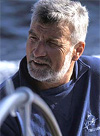 Jean-Luc
Van Den Heede, Navigator and Record Holder of the solo non-stop
westward circumnavigation by sailboat. Ten
Jean-Luc
Van Den Heede, Navigator and Record Holder of the solo non-stop
westward circumnavigation by sailboat. Ten 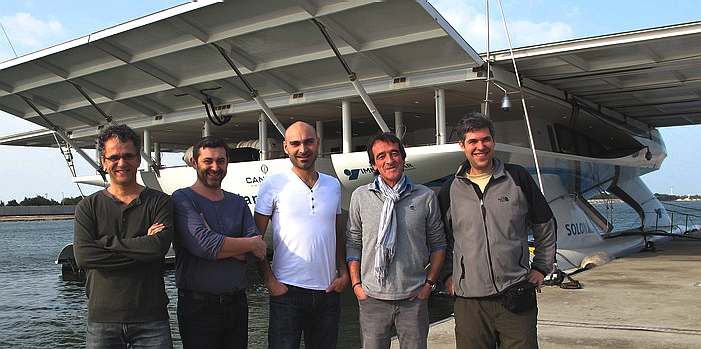

 Fernand Cuche
Fernand Cuche